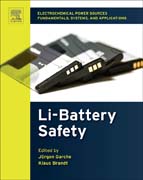
Safety of Lithium Batteries describes how best to assure safety during all phases of the life of Lithium ion batteries (production, transport, use, and disposal). About 5 billion Li-ion cells are produced each year, predominantly for use in consumer electronics. This book describes how the high energy density and outstanding performance of Li-ion batteries will result in a large increase in the production of Li-ion cells for electric drive train vehicle (xEV) and battery energy storage (BES or EES) purposes. The high energy density of Li battery systems comes with special hazards related to the materials employed in these systems. The manufacturers of cells and batteries have strongly reduced the hazard probability by a number of measures. However, absolute safety of the Li system is not given as multiple incidents in consumer electronics have shown. Presents the relation between chemical and structure material properties and cell safetyRelates cell and battery design to safetyCovers system operation parameters and safety Outlines the influences of abuses on safety and the relationship to battery testingLists the limitations for transport and storage of cells and batteriesIncludes recycling, disposal and second use of lithium ion batteries INDICE: 1. General safety considerations 2. General overview of non-lithium battery systems and their safety issues 3. Overview of Li battery systems 4. Safety aspects of Li-primary batteries 5. General overview of Li-secondary battery safety issues 6. Li-secondary battery Risks - Sources and their effects 6A. Risk potentials 6B. Sources of risks 6C. Chemical reaction to risk scenarios 6D. SOC and SOH influences on risk 7. Li-secondary battery - Risk management by manufacturers 7A. Managing of risk by cell manufacturers 7B. Managing of risk by battery manufacturers 7C. Managing of risk by car manufacturers 7D. Managing of risk by manufacturers of consumer equipment 7E. Managing of risk by manufacturers of BESS 8. Li-secondary battery - Risk management by users and stakeholders 8A. Managing of general risks by users and stakeholders 8B. Managing of risk by EV users 8C. Managing of risk by users in non EV markets 9. Li-secondary battery - Safety Tests 9A. Safety Tests 9B. Modeling of Safety Tests/Events 10. Li-secondary battery - Special Risks 10A. Special risks during transport and storage 10B. Special risks during disposal Li-secondary battery - Damage Control 11A. Handling of safety incidents 11B. Procedures for incident investigations 11C. Fire fighting 11D. Overview about accidents Selected lessons learned from prior safety-related failures of Li-secondary batteries 12. Outlook
- ISBN: 978-0-444-63777-2
- Editorial: Elsevier
- Encuadernacion: Cartoné
- Páginas: 510
- Fecha Publicación: 01/10/2017
- Nº Volúmenes: 1
- Idioma: Inglés
